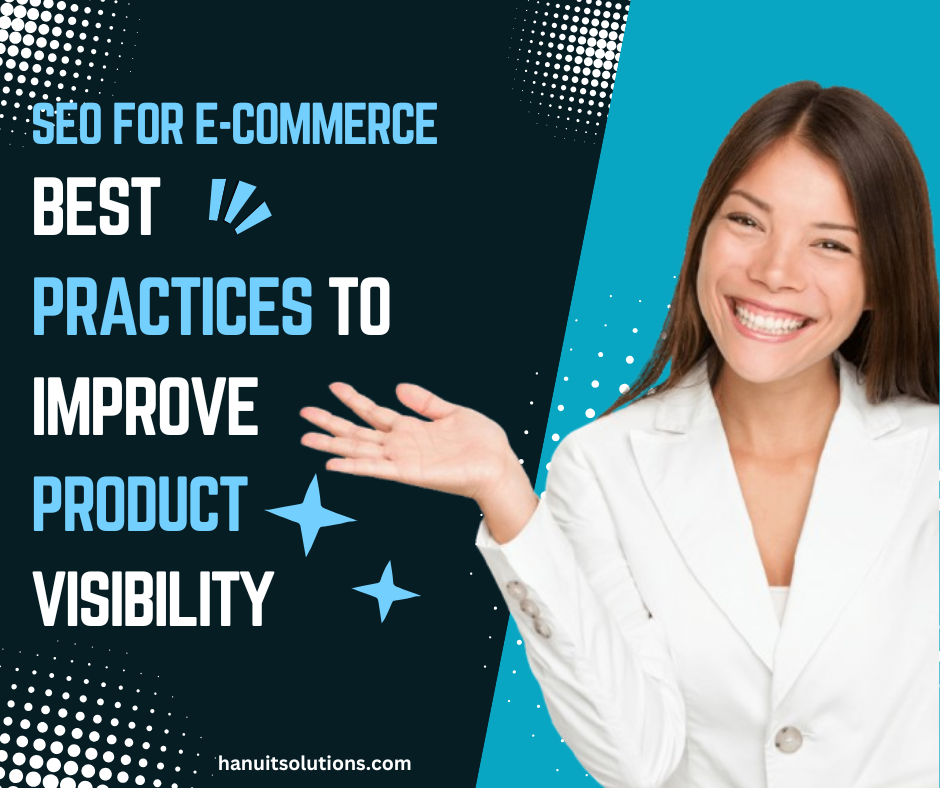SEO for E-commerce: Best Practices to Improve Product Visibility
In the competitive world of online retail, mastering SEO for E-commerce is essential to ensure your products get the attention they deserve. Search Engine Optimization tailored for e-commerce platforms can help improve product visibility, attract targeted traffic, and boost sales. By implementing the right strategies, you can make your online store stand out and turn visitors into loyal customers.
This guide focuses on the best practices for optimizing your e-commerce store for search engines, helping you achieve better rankings and connect with your audience effectively.
Learn how to boost your online store’s performance with SEO for E-commerce! In this video, we cover:
- Proven techniques to enhance product visibility.
- Best practices for optimizing e-commerce websites.
- Effective strategies for keyword research and implementation.
- Tips to improve site speed, structure, and mobile-friendliness.
If you want to drive more traffic to your online store and increase your sales, this is the ultimate guide to mastering SEO for E-commerce. Subscribe now for expert insights and actionable tips!

Understanding SEO for E-commerce
SEO for e-commerce involves optimizing your online store and product pages to increase visibility in search engine results pages (SERPs). Unlike traditional websites, e-commerce platforms have unique challenges such as duplicate content, thin product descriptions, and high competition. Addressing these challenges with targeted SEO techniques can significantly impact your site’s performance and revenue.
Why SEO Matters for E-commerce
Search Engine Optimization (SEO) is the process of improving your website’s ranking on search engines like Google. For e-commerce businesses, this is crucial because:
- Increased Visibility: Most online shoppers start their journey with a search engine query. A high-ranking website attracts more organic traffic.
- Higher ROI: SEO is cost-effective compared to paid advertising. Once optimized, your site can drive consistent traffic without ongoing ad expenses.
- Improved User Experience: Many SEO practices, such as fast loading times and mobile optimization, enhance user experience, encouraging shoppers to stay longer and purchase more.
Now, let’s delve into the best practices for optimizing your e-commerce store.
Best Practices to Improve Product Visibility
1. Perform Comprehensive Keyword Research
Effective keyword research lays the foundation for any successful e-commerce SEO strategy. Follow these steps:
- Identify Long-tail Keywords: Focus on long-tail keywords (e.g., “women’s waterproof hiking boots”) to target niche audiences with high purchase intent.
- Use SEO Tools: Tools like Google Keyword Planner, Ahrefs, or SEMrush can help identify relevant keywords with high search volume and low competition.
- Analyze Competitor Keywords: Study competitors in your niche to discover opportunities to rank for overlooked keywords.
Incorporate these keywords naturally into your product titles, descriptions, and meta tags to improve visibility.
2. Optimize Product Pages
Your product pages are the heart of your e-commerce website. Here’s how to optimize them:
- Write Unique Product Descriptions: Avoid duplicate content by crafting original, detailed, and engaging descriptions for each product. Include primary and secondary keywords naturally.
- Use Descriptive Titles: Product titles should include relevant keywords and clearly describe the item (e.g., “Men’s Black Leather Jacket – Slim Fit”).
- Leverage High-quality Images: Optimize images with descriptive file names and alt tags containing relevant keywords. Compress images to reduce loading times.
- Add Customer Reviews: Positive reviews build trust and contribute to fresh, user-generated content, which search engines favor.
3. Improve Site Structure
A well-organized site structure enhances user experience and makes it easier for search engines to crawl your website.
- Categorization: Group products into logical categories and subcategories.
- Breadcrumb Navigation: Enable breadcrumb navigation to help users and search engines understand your site hierarchy.
- URL Structure: Use clean, descriptive URLs that include keywords,
4. Optimize for Mobile Users
With the majority of e-commerce traffic coming from mobile devices, mobile optimization is critical:
- Responsive Design: Ensure your website adapts seamlessly to different screen sizes.
- Fast Loading Times: Compress images and leverage caching to reduce page load times.
- Mobile-friendly Navigation: Use a simple menu structure and large, tappable buttons.
Google prioritizes mobile-friendly sites in its rankings, so neglecting this aspect could harm your visibility.
Also read: Google My Business Optimization for Brick-and-Mortar Stores: A Checklist
5. Focus on Technical SEO
Technical SEO ensures that search engines can easily crawl and index your website:
- Improve Site Speed: Use tools like Google PageSpeed Insights to identify and fix performance issues.
- Optimize URLs: Use clean, descriptive URLs with keywords (e.g., “example.com/black-leather-jacket”).
- Fix Broken Links: Regularly audit your site for 404 errors and update or remove broken links.
- Submit a Sitemap: Provide a sitemap to search engines to help them discover your pages more efficiently.
6. Build High-Quality Backlinks
Backlinks from reputable websites boost your domain authority:
- Collaborate with Influencers: Partner with influencers in your niche to review and link to your products.
- Submit Guest Posts: Write articles for industry blogs with backlinks to your e-commerce site.
- Engage in Online Communities: Participate in forums and answer questions on platforms like Quora, including links to your store where relevant.
7. Leverage Content Marketing
Engaging content attracts visitors and improves your site’s authority:
- Start a Blog: Write articles about industry trends, product tutorials, and buying guides. For instance, a clothing store might publish “How to Style a Leather Jacket.”
- Create Videos: Product demos and reviews can rank well on both Google and YouTube.
- Share on Social Media: Promote your content on social platforms to drive traffic and build backlinks.
8. Encourage Customer Reviews
Customer reviews not only build trust but also improve search visibility. Encourage satisfied customers to leave reviews and respond to them to show engagement. Highlight reviews on your product pages to enhance their appeal.
9. Monitor Analytics and Performance
Regularly assess your SEO efforts to identify areas for improvement.
- Analytics Tools: Use Google Analytics and Google Search Console to monitor traffic and performance.
- A/B Testing: Test different strategies to see what works best for your audience.
- SEO Audits: Conduct periodic audits to ensure your site remains optimized.
Adjust your SEO strategies based on the data to continually improve.
10. Optimize for Local SEO
If you have a physical store or cater to specific regions, local SEO can drive targeted traffic:
- Claim Your Google My Business Listing: Include accurate details about your business location, hours, and contact information.
- Use Local Keywords: Incorporate location-based keywords (e.g., “organic groceries in Los Angeles”) in your content.
- Encourage Local Reviews: Positive reviews on platforms like Google and Yelp improve your local search rankings.
FAQ:
What is SEO for E-commerce?
SEO for e-commerce involves optimizing your online store to improve its visibility on search engines, making it easier for potential customers to find your products.
Why is keyword research important for e-commerce SEO?
Keyword research identifies the terms shoppers use to find products like yours. By targeting these keywords, you can attract more relevant traffic to your site.
How do I optimize product images for SEO?
Use descriptive file names, add keyword-rich alt tags, and compress images to improve loading times and visibility on search engines.
What role does mobile optimization play in e-commerce SEO?
Mobile optimization ensures your site provides a seamless shopping experience on mobile devices, which is essential as most online shoppers use smartphones.
How can I measure the success of my e-commerce SEO efforts?
Use analytics tools to track metrics like organic traffic, keyword rankings, CTR, and conversion rates to gauge your SEO performance.
Conclusion
SEO for e-commerce is a powerful tool that can significantly enhance product visibility and drive sales. By implementing these best practices—from thorough keyword research to technical optimization and content marketing—you can ensure your online store stands out in a crowded marketplace. Staying consistent and adapting to evolving trends will keep your e-commerce business competitive. Start optimizing your site today to attract more customers and achieve long-term growth.








